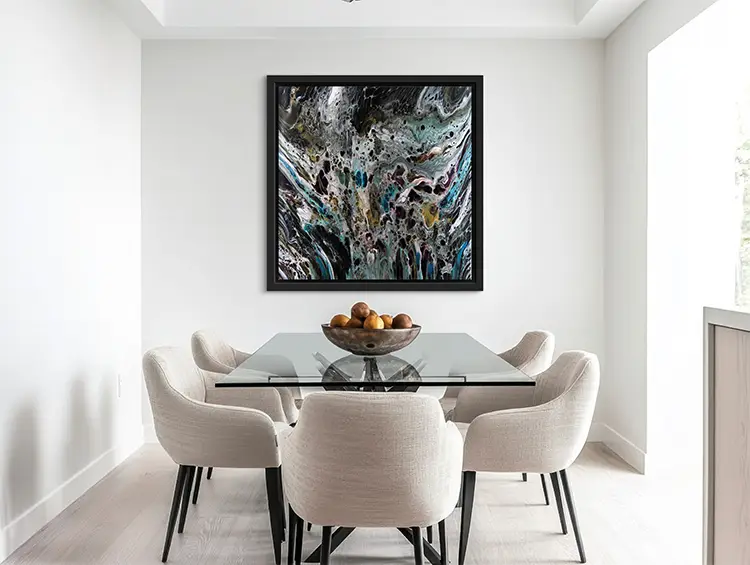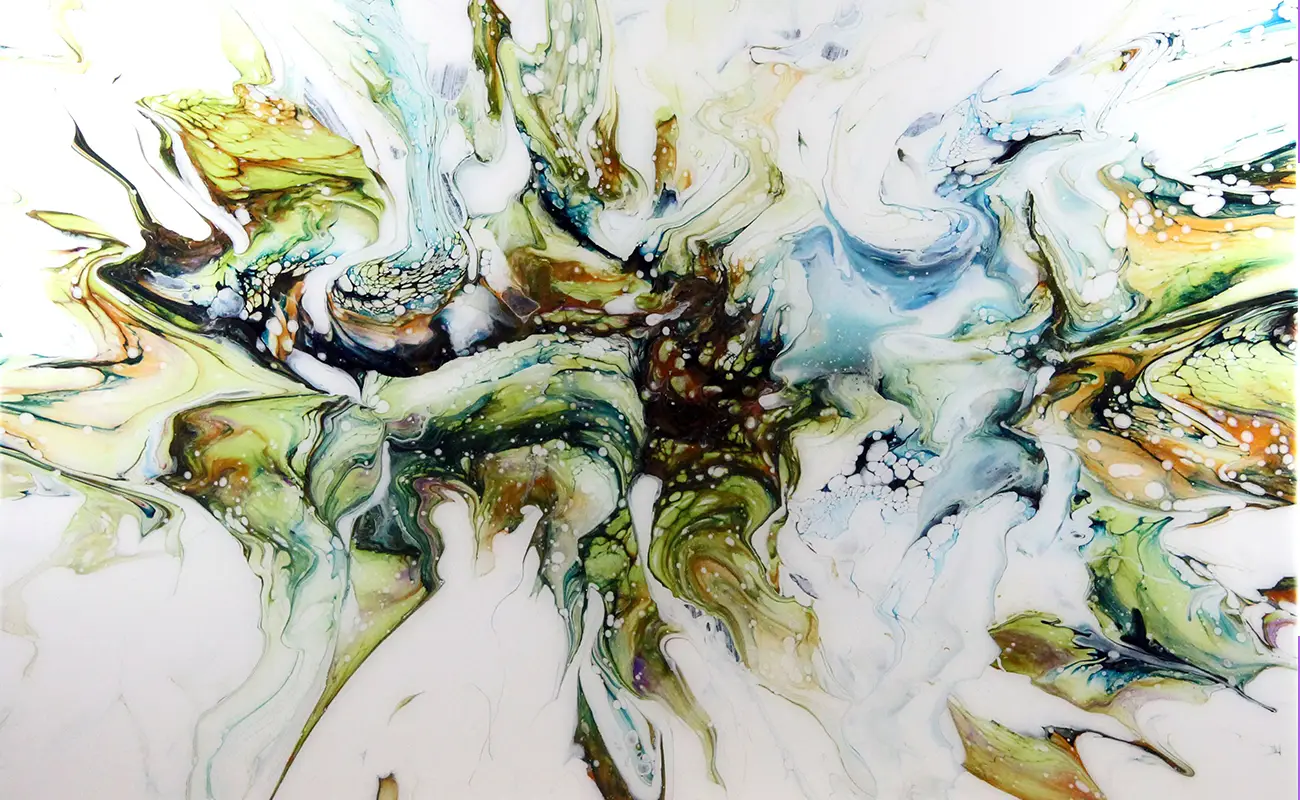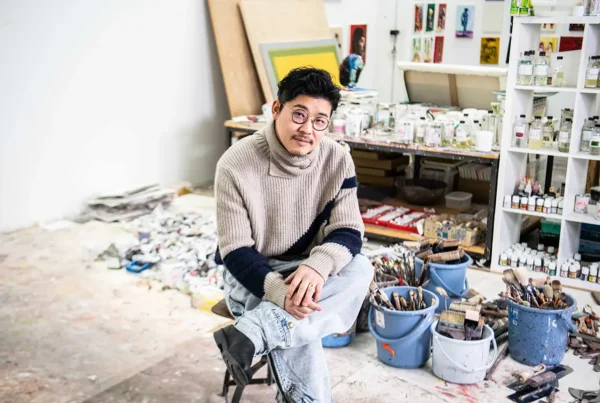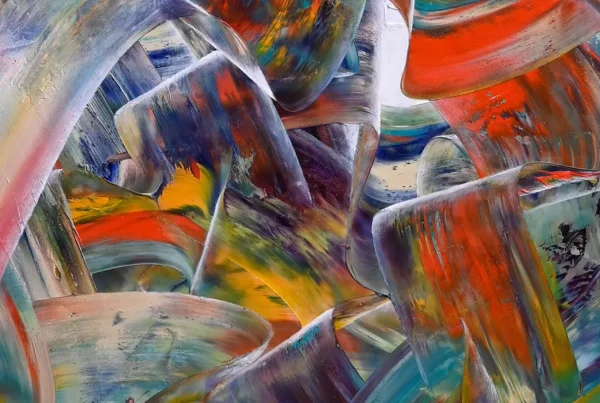“My studio is more reminiscent to a mad scientist laboratory than a painting studio.”
Where Roots Meet Resonance
Vibrant dualities pulse at the core of Roma Finlinson’s practice, giving her work a striking tension between raw natural energy and the structured pulse of modern city life. Born in Trinidad and now based in London, Finlinson’s visual language springs from these sharply contrasting environments. The lush biodiversity of her childhood, full of tangled greenery and ocean rhythms, collides with the sharp edges and metallic chill of urban architecture, creating an aesthetic that is both disorienting and magnetic. Her canvases are not passive surfaces—they vibrate, react, and shift, much like the ecological and psychological currents they seek to interpret.
This cultural and environmental dichotomy is more than visual contrast—it fuels Finlinson’s deeper artistic intentions. The rich palette of her Caribbean upbringing, informed by tropical flora, coastal movement, and dynamic wildlife, formed an early sensitivity to texture, color, and rhythm. Arriving in London, she encountered a new kind of visual density: sprawling skylines, architectural geometry, and the charged pace of a global metropolis. Instead of choosing between the two, Finlinson absorbed both, allowing their visual vocabularies to overlap and clash within her paintings, much like emotional states within the human mind.
The thematic spectrum she explores is no less complex. At the intersection of personal memory and collective future, Finlinson’s paintings reflect a restlessness toward humanity’s current trajectory. She confronts issues as heavy as mental health, political instability, and ecological legacy—not through overt symbolism, but through layered abstraction. Her work oscillates between volatility and serenity, capturing both eruption and calm. Whether inspired by a stubborn pigment or a moment of stillness in cured resin, each composition becomes a confrontation: an emotional reckoning rendered in color, texture, and form.
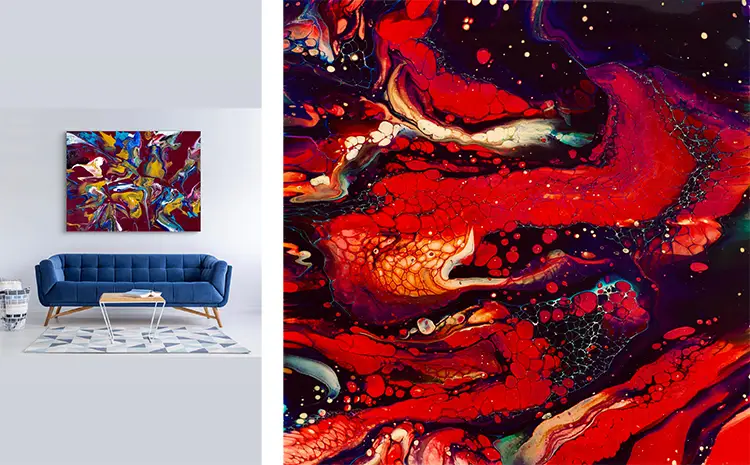
Roma Finlinson: Art as Catalyst and Containment
Finlinson’s entry into full-time artistic practice emerged not from academic convention but from a profound personal pivot. Like many, her life was reshaped by the pandemic—but instead of retreating, she expanded. With the encouragement of her husband, who built her a garden studio intended for pottery, Finlinson discovered that painting—not ceramics—was the true gravitational force in her life. The studio’s kiln stands unused, a silent monument to a path not taken. Instead, the space has become an incubator for exploration, a place where intuition, chemistry, and obsession collide on canvas.
Within this creative sanctuary, Finlinson plunged into technical experimentation with a fervor that borders on scientific. Pigments and catalysts, binders and solvents—all were tested and combined, not just to achieve visual effect but to mimic the unpredictable energy of organic life and decay. Over time, the studio took on a new identity: less art room, more chemical lab. Paintings were not merely painted; they were grown, forged, reacted into existence. In the chemical behaviors of mixed materials, Finlinson saw parallels with emotional volatility and societal transformation—uncontrolled, chaotic, yet mysteriously beautiful.
This approach culminated in a breakthrough with a piece titled Self Possessed, a painting Finlinson describes as a moment where everything began to cohere. After extensive material trials and visual dead ends, this artwork marked her transition from experimentation to conviction. It was here that technique met voice, where her aesthetic ambitions and emotional truths aligned. In Self Possessed, she didn’t just produce a painting—she claimed a definitive identity as an artist. The title speaks to both the inner clarity she achieved and the ownership of her stylistic direction, marking it as a turning point in her practice.
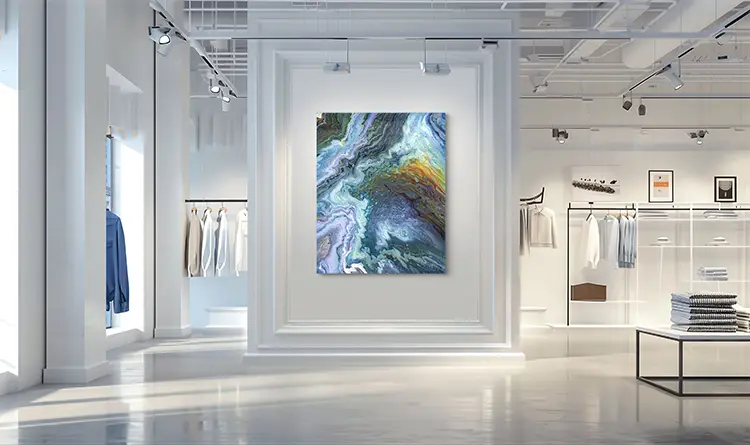
A Laboratory of Sensation
The physical space in which Finlinson creates is an extension of her visual themes: unpredictable, reactive, and charged with purpose. Far removed from the whitewashed stillness of conventional art studios, hers resembles something between a geologist’s archive and an alchemist’s bench. It is littered with rocks, crystals, and oxidized objects—each a fossil of transformation, each whispering a narrative of elemental change. These tactile inspirations aren’t merely aesthetic cues; they serve as benchmarks for the surface reactions she seeks to replicate in her painting processes.
Working among these items, Finlinson treats her materials not as tools but as living entities with their own desires and failures. She invites instability, hoping for unexpected interactions between compounds and colors. This openness to unpredictability informs not only the visual surface but the energy embedded in her work. Paintings may blister, crack, shimmer, or pool in ways she cannot fully control—and that is precisely the point. This tension between control and surrender reflects the emotional themes she explores, from mental instability to cultural dislocation.
Handling distractions in this space requires not so much discipline as surrender. Finlinson does not cordon off the outside world; instead, she lets its chaos bleed into her process. The unpredictability of each day mirrors the alchemy on her canvas. This synergy between environment and execution ensures her work remains in motion—never static, never entirely resolved. In this way, her studio becomes both a sanctuary and a crucible, where thought, material, and mood are fused under creative pressure.
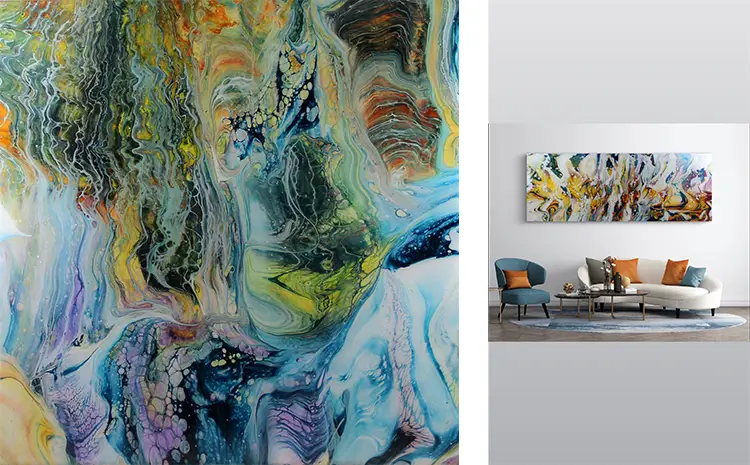
Roma Finlinson: Where Vulnerability Meets Velocity
Finlinson’s influences span both technique and temperament, drawn from artists who marry personal rawness with painterly control. Among them, Nancy Wood stands out as a key inspiration, particularly for the way she manipulates paint to convey emotional nuance without losing structural elegance. Finlinson’s own work resonates with this sensibility, layering abstraction with emotional depth that lingers just beneath the surface. She channels similar emotional currents while forging a visual syntax entirely her own.
Another towering influence is Frida Kahlo, whose intensely autobiographical paintings broke ground for artists unafraid to bare their inner lives. What Finlinson finds most compelling in Kahlo is not just the technical craft, but the sheer vulnerability that pulses through her canvases. That willingness to create from pain, memory, and identity informs Finlinson’s own ethos. Her work, too, often springs from a confrontation with inner turbulence—transformed not into literal imagery, but into texture, movement, and resonance. In this way, she pays homage to Kahlo not by imitation, but by embodying her courage.
This emotional fidelity—to oneself, to the process, to the viewer—is perhaps the binding thread in Finlinson’s evolving practice. Each piece is a risk, an attempt to reconcile competing influences and ideas: past and present, science and soul, fracture and repair. Rather than retreat into neat categories, she embraces the friction between disciplines and histories. Her work is not concerned with resolving these tensions but with giving them space to exist, to argue, and to transform. In doing so, Roma Finlinson offers not just paintings, but proof that vulnerability, when embraced with clarity, can become a driving force for innovation.
